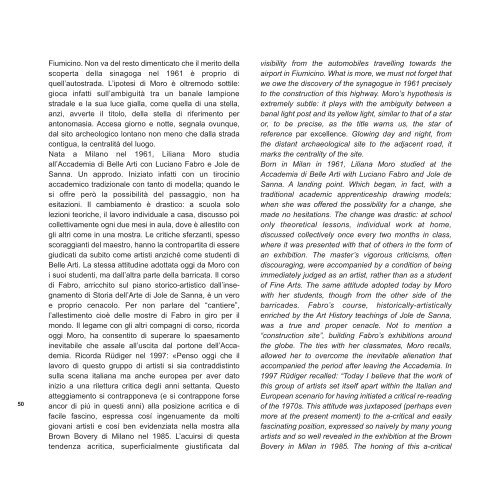Adachiara Zevi - arteinmemoria
Adachiara Zevi - arteinmemoria
Adachiara Zevi - arteinmemoria
You also want an ePaper? Increase the reach of your titles
YUMPU automatically turns print PDFs into web optimized ePapers that Google loves.
50<br />
Fiumicino. Non va del resto dimenticato che il merito della<br />
scoperta della sinagoga nel 1961 è proprio di<br />
quell’autostrada. L’ipotesi di Moro è oltremodo sottile:<br />
gioca infatti sull’ambiguità tra un banale lampione<br />
stradale e la sua luce gialla, come quella di una stella,<br />
anzi, avverte il titolo, della stella di riferimento per<br />
antonomasia. Accesa giorno e notte, segnala ovunque,<br />
dal sito archeologico lontano non meno che dalla strada<br />
contigua, la centralità del luogo.<br />
Nata a Milano nel 1961, Liliana Moro studia<br />
all’Accademia di Belle Arti con Luciano Fabro e Jole de<br />
Sanna. Un approdo. Iniziato infatti con un tirocinio<br />
accademico tradizionale con tanto di modella; quando le<br />
si offre però la possibilità del passaggio, non ha<br />
esitazioni. Il cambiamento è drastico: a scuola solo<br />
lezioni teoriche, il lavoro individuale a casa, discusso poi<br />
collettivamente ogni due mesi in aula, dove è allestito con<br />
gli altri come in una mostra. Le critiche sferzanti, spesso<br />
scoraggianti del maestro, hanno la contropartita di essere<br />
giudicati da subito come artisti anziché come studenti di<br />
Belle Arti. La stessa attitudine adottata oggi da Moro con<br />
i suoi studenti, ma dall’altra parte della barricata. Il corso<br />
di Fabro, arricchito sul piano storico-artistico dall’insegnamento<br />
di Storia dell’Arte di Jole de Sanna, è un vero<br />
e proprio cenacolo. Per non parlare del “cantiere”,<br />
l’allestimento cioè delle mostre di Fabro in giro per il<br />
mondo. Il legame con gli altri compagni di corso, ricorda<br />
oggi Moro, ha consentito di superare lo spaesamento<br />
inevitabile che assale all’uscita dal portone dell’Accademia.<br />
Ricorda Rüdiger nel 1997: «Penso oggi che il<br />
lavoro di questo gruppo di artisti si sia contraddistinto<br />
sulla scena italiana ma anche europea per aver dato<br />
inizio a una rilettura critica degli anni settanta. Questo<br />
atteggiamento si contrapponeva (e si contrappone forse<br />
ancor di piú in questi anni) alla posizione acritica e di<br />
facile fascino, espressa cosí ingenuamente da molti<br />
giovani artisti e cosí ben evidenziata nella mostra alla<br />
Brown Bovery di Milano nel 1985. L’acuirsi di questa<br />
tendenza acritica, superficialmente giustificata dal<br />
visibility from the automobiles travelling towards the<br />
airport in Fiumicino. What is more, we must not forget that<br />
we owe the discovery of the synagogue in 1961 precisely<br />
to the construction of this highway. Moro’s hypothesis is<br />
extremely subtle: it plays with the ambiguity between a<br />
banal light post and its yellow light, similar to that of a star<br />
or, to be precise, as the title warns us, the star of<br />
reference par excellence. Glowing day and night, from<br />
the distant archaeological site to the adjacent road, it<br />
marks the centrality of the site.<br />
Born in Milan in 1961, Liliana Moro studied at the<br />
Accademia di Belle Arti with Luciano Fabro and Jole de<br />
Sanna. A landing point. Which began, in fact, with a<br />
traditional academic apprenticeship drawing models;<br />
when she was offered the possibility for a change, she<br />
made no hesitations. The change was drastic: at school<br />
only theoretical lessons, individual work at home,<br />
discussed collectively once every two months in class,<br />
where it was presented with that of others in the form of<br />
an exhibition. The master’s vigorous criticisms, often<br />
discouraging, were accompanied by a condition of being<br />
immediately judged as an artist, rather than as a student<br />
of Fine Arts. The same attitude adopted today by Moro<br />
with her students, though from the other side of the<br />
barricades. Fabro’s course, historically-artistically<br />
enriched by the Art History teachings of Jole de Sanna,<br />
was a true and proper cenacle. Not to mention a<br />
“construction site”, building Fabro’s exhibitions around<br />
the globe. The ties with her classmates, Moro recalls,<br />
allowed her to overcome the inevitable alienation that<br />
accompanied the period after leaving the Accademia. In<br />
1997 Rüdiger recalled: “Today I believe that the work of<br />
this group of artists set itself apart within the Italian and<br />
European scenario for having initiated a critical re-reading<br />
of the 1970s. This attitude was juxtaposed (perhaps even<br />
more at the present moment) to the a-critical and easily<br />
fascinating position, expressed so naively by many young<br />
artists and so well revealed in the exhibition at the Brown<br />
Bovery in Milan in 1985. The honing of this a-critical


